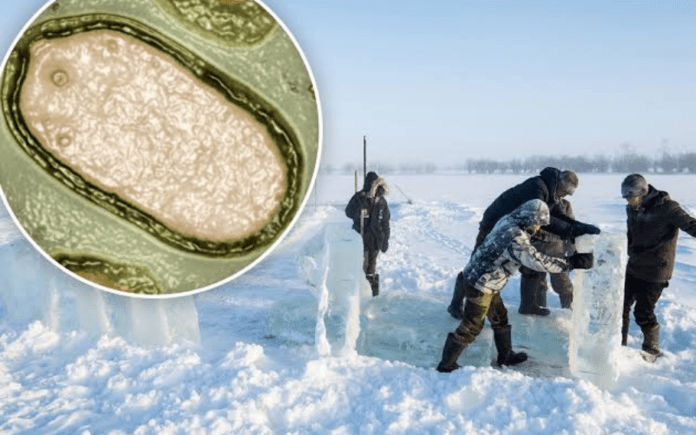Unearthing Ancient viruses: Jean-Michel Claverie’s Pioneering Research
As the world grapples with the aftermath of the COVID-19 pandemic, a new potential threat looms on the horizon – zombie viruses preserved in the permafrost of Russia. These ancient pathogens, capable of surviving thousands of years in frozen stasis, pose a significant risk to humanity, for which there is no existing immunity or treatment.
At the forefront of this research is Jean-Michel Claverie, an emeritus professor at Aix-Marseille University’s School of Medicine. For over a decade, Claverie has delved into the study of “giant” viruses, some nearly 50,000 years old, unearthed from the layers of Siberian permafrost. This exploration sheds light on the alarming consequences of global warming, which is gradually thawing the ground that has remained frozen for millennia.
The Arctic, already 1.2 degrees Celsius warmer than pre-industrial times, faces the possibility of ice-free summers by the 2030s. While much attention has been given to the release of trapped greenhouse gases like methane, the peril of dormant pathogens has received less scrutiny. In 2017, Claverie’s team published research revealing the successful extraction of multiple ancient viruses from Siberian permafrost, all of which remained infectious.
Implications of Thawing Permafrost: A Looming Threat Amidst Global Warming
Claverie emphasized the emergence of potential threats from the north due to permafrost thawing, a departure from the traditional focus on climate change dangers originating from warmer tropical regions. This concern materialized vividly in 2016 when a heat wave in Siberia activated anthrax spores, leading to dozens of infections and tragic losses of both human and animal life. In a separate breakthrough, scientists demonstrated the revival of a 46,000-year-old roundworm from Siberian permafrost through rehydration, uncovering the phenomenon of cryptobiosis – a state of suspended animation in multicellular organisms.

While global health agencies and governments have long been vigilant for unknown infectious diseases, the emergence of a potential “Disease X” remains a top priority for research, particularly in the wake of the COVID-19 pandemic. Claverie’s pioneering work at the intersection of permafrost, ancient pathogens, and global warming offers critical insights into a potential threat that demands our attention and preparedness.
As the stability of permafrost layers, intact for 400,000 years, is now threatened by rapid Arctic warming, the delicate balance between scientific exploration and inadvertent propagation of danger looms large. In the face of these challenges, Claverie’s decision not to return to Siberia underscores the gravity of the situation and the need for caution in further expeditions into the frozen depths.
Jean-Michel Claverie’s fascination with permafrost and its potential revelations began with the revival of a flowering plant frozen for 30,000 years. This led him to delve into the potential resurrection of viruses from ancient permafrost. In 2014, he demonstrated the revival of “live” viruses from Siberian permafrost, focusing on viruses infecting amoebas to prevent accidental human contamination. In 2019, his team isolated 13 new viruses, one of which had been frozen for over 48,500 years, from various ancient Siberian permafrost samples, underscoring their widespread presence.
The potential consequences of an unknown ancient pathogen resurfacing in humans, as warned by Claverie, are potentially “disastrous”, he cited the extinction of Neanderthals as an example. The unique conditions of permafrost, lacking oxygen and chemical activity, make it an ideal preserver of organic matter. Siberia, home to permafrost layers up to a kilometer deep, harbors thousands of dormant microbe species in just one gram of soil.
However, the stability of permafrost layers, intact for 400,000 years, is now threatened as the Arctic warms at an alarming rate. Methane craters and sinking towns are emerging across the region. Geopolitical tensions have further complicated research, hindering collaboration with Russian labs and colleagues.
While global warming poses risks to Russian infrastructure and contributes to environmental disasters, the region holds vast natural resources. Russia’s active mining of permafrost raises concerns about human interaction with ancient pathogens. The dilemma lies in inadvertently propagating danger while researching potential threats.
Some advocate less resource-intensive approaches, like monitoring the Inuit population for diseases linked to permafrost. Larger organizations are also reconsidering their virus-hunting projects due to concerns about sparking pandemics.
Claverie, regardless of the war’s outcome, has decided not to return to Siberia. He believes he has conveyed the existence of the danger and that further expeditions into the frozen depths would be unwise. The urgency of the situation demands not only scientific rigor but also a thoughtful and cautious approach to this potentially existential threat.












